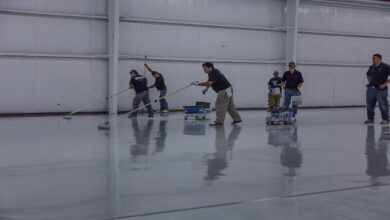Exploring Concrete Cutting and Drilling: Techniques and Applications
Concrete Cutting and Drilling

- What is concrete cutting and drilling?
- What are the methods of exploration drilling?
- What are the applications of drilling technology?
- What are the different methods of drilling concrete?
Concrete cutting and drilling are specialized techniques used in construction, renovation, and demolition projects. These processes involve precise removal or penetration of concrete structures to accommodate various requirements.
From creating openings for doors and windows to modifying existing structures, concrete cutting and drilling play a crucial role in shaping the built environment. In this article, we will delve into the world of concrete cutting and drilling, exploring the techniques, equipment, and applications involved.
Concrete Cutting Techniques:
Concrete cutting refers to the process of removing sections of concrete using specialized tools and equipment. Several techniques are commonly employed:
- Diamond Sawing: Diamond sawing is the most prevalent method for cutting through concrete. It utilizes diamond-tipped blades or wires, which are highly durable and capable of cutting through various densities of concrete. Diamond sawing can be performed using handheld saws, wall-mounted saws, or floor saws, depending on the specific requirements of the project.
- Wall Sawing: Wall sawing is used to create precise openings in vertical or inclined concrete surfaces, such as walls or slabs. It involves the use of a specialized track-mounted saw that can cut through thick concrete sections while maintaining accuracy and minimizing vibrations.
- Flat Sawing: Flat sawing, also known as slab sawing, is employed to cut horizontal surfaces, such as pavements, floors, or bridges. It utilizes large, walk-behind saws equipped with diamond blades to achieve clean and straight cuts.
- Wire Sawing: Wire sawing is employed when conventional sawing methods are not feasible due to the size or thickness of the concrete. It involves the use of a continuous loop of diamond wire, which is threaded through a series of pulleys and driven by hydraulic or electric power. Wire sawing is ideal for cutting through heavily reinforced concrete or for creating irregular shapes and openings.
Concrete Drilling Techniques:
Concrete drilling involves creating holes or penetrations in concrete structures to accommodate various installations, such as pipes, cables, or anchor bolts. Different techniques are employed:
- Core Drilling: Core drilling is the most common method for creating precise circular holes in concrete. It utilizes a cylindrical drill bit with diamond teeth to remove a core of concrete. Core drills can be handheld or mounted on a rig, allowing for accurate and efficient drilling of different diameters and depths.
- Stitch Drilling: Stitch drilling involves creating a series of overlapping holes to form larger openings or remove sections of concrete. It is particularly useful when working with thick or heavily reinforced concrete.
- Dowel Hole Drilling: Dowel hole drilling is employed for inserting dowels or reinforcing bars into existing concrete structures. It ensures proper alignment and connection of concrete elements, such as columns, beams, or walls.
Applications of Concrete Cutting and Drilling:
Concrete cutting and drilling techniques find extensive application in various construction and renovation projects:
Structural Modifications: Concrete cutting and drilling are utilized to create openings for doors, windows, vents, or ductwork in existing concrete walls or slabs. They enable seamless integration of new elements into the structure while maintaining its integrity.
Plumbing and Electrical Installations: Concrete drilling is essential for creating holes to accommodate plumbing pipes, electrical conduits, or wiring systems in both residential and commercial buildings.
Demolition and Renovation: Concrete cutting techniques are employed during demolition projects to remove specific sections of concrete structures. They facilitate the dismantling of obsolete or damaged elements, allowing for renovation and remodeling.
Infrastructure Development: Concrete cutting and drilling are crucial in infrastructure projects, such as highway construction, bridge modification, or tunneling. They help create precise openings, accommodate utilities, or modify existing structures to meet the evolving needs of transportation networks.
Decor ative Applications: Concrete cutting and drilling techniques are also used for decorative purposes. Intricate patterns, designs, or logos can be created by cutting or etching into concrete surfaces. This adds a unique aesthetic touch to floors, walls, or pavements in commercial spaces, parks, or public areas.
Final Though
Concrete cutting and drilling are specialized techniques that play a vital role in the construction, renovation, and demolition industries. These processes allow for precise removal or penetration of concrete structures, enabling modifications, installations, or structural enhancements. From creating openings for doors and windows to accommodating plumbing and electrical systems, concrete cutting and drilling are essential for shaping the built environment. By employing advanced tools and techniques such as diamond sawing, wall sawing, core drilling, and wire sawing, professionals can achieve accurate and efficient results while maintaining the integrity of the concrete structures. Understanding the various applications and techniques of concrete cutting and drilling is crucial for architects, contractors, and construction professionals to successfully execute projects and bring their visions to life.




